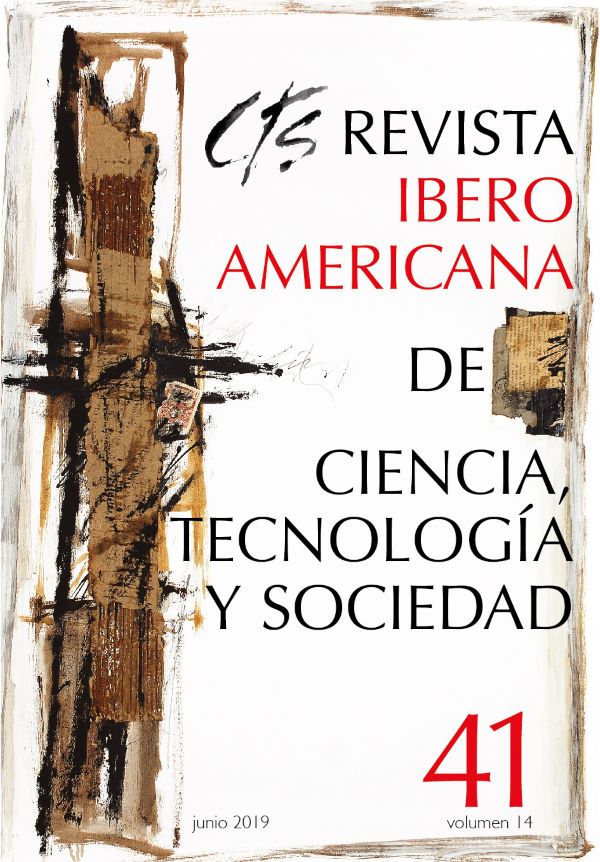Ingeniería y preocupación social: hacia nuevas prácticas
Palabras clave:
determinismo tecnológico, innovación frugal, acción colectiva, enseñanza CTS, ingenieríaResumen
A partir de la constatación de que se está produciendo una identificación entre irreversibilidad tecnológica e inevitabilidad tecnológica —es decir, la negación de la posibilidad de construir alternativas a lo que existe—, este trabajo argumenta que ello no es así y que dicha construcción requiere una discusión reflexiva de nuevas prácticas en la enseñanza de la ingeniería. Ello es imprescindible para estimular una preocupación social entre estudiantes de vertientes científicotécnicas que ayude a enfrentar los desafíos del cambio climático, de la desigualdad y de la deriva antidemocrática en la aplicación de la informática.Descargas
Citas
ABROL, D. (2014): “Pro-poor Innovation Making, Knowledge Production, and technology Implementation for Rural Areas: Lessons from the Indian Experience”, Innovation in India. Combining Economic Growth with Inclusive Development, Nueva Delhi, Cambridge University Press, pp. 337-378.
ANDERSEN, E. (1995): Feasibility Study in New Awareness Initiatives, Copenhagen, Danish Board Of Technology.
ASIMOV, I. (1974): Los propios dioses, Madrid, Bruguera.
BRYNJOLFSSON, E. y MC AFEE, A. (2014): The Second Machine Age. Work, Progress, and Prosperity in a Time of Brilliant Technologies, Nueva York, Norton and Co.
DAVID, P. (1985) “Clio and the Economics of QWERTY”, The American Economic Review, vol. 75, n° 2, pp. 332-337.
DERTOUZOS, M. L., LESTER, R. K., SOLOW, R. M. y MIT COMMISSION ON INDUSTRIAL PRODUCTIVITY (1989): Made in America: Regaining the Productive Edge, Cambridge, MIT Press.
EHN, P. (1988): Work-Oriented Design of Computer Artifacts, Umea University. Disponible en: https://www.diva-portal.org/smash/get/diva2:580037/FULLTEXT02.pdf. Consultado el 10 de enero de 2019.
GEIDO, D., FAILACHE, H. y SIMINI, F. (2007): “BiliLED fototerapia neonatal de bajo costo: del prototipo a la producción industrial”, Proceedings of the XVI Congreso Argentino de Bioingeniería, V Jornadas de Ingeniería Clínica, San Juan, Argentina. Disponible en: http://www.nib.fmed.edu.uy/bililed_sabi.pdf. Consultado el 21 de abril de 2019.
GERTH, H. y WRIGHT, C. (1991): From Max Weber, Oxford, Routledge.
GUARGA, R. (2012): “Jornada Técnica: La tecnología SIS aplicada al control y prevención del riesgo de heladas en Uruguay”, INIA Las Brujas. Disponible en: http://www.ainfo.inia.uy/digital/bitstream/item/3740/1/SIS41031163325667.pdf. Consultado el 21 de abril de 2019.
HOARE, C. (1981): “The 1980 ACM Turing Award Lecture: The Emperor Old Clothes”, Communications of the ACM, vol. 24, n° 2, pp. 75-83.
KAMP, L. (2010): “The Development of Wind Power in the Netherlands and Denmark”, en P. Strachan, D. Toke y D. Lal (eds.): Wind Power and Power Politics. International Perspectives, Nueva York, Palgrave, pp. 183-202.
LUNDVALL, B. Å. (1985): “Product Innovation and User-Producer Interaction”, Industrial Development Research Series, n° 31, Aalborg University Press.
MISA, T. (1994): “Retrieving Sociotechnical Change from Technological Determinism”, en M. R. Smith y L. Marx (eds.): Does Technology Drive History? The dilema of technological determinism, Nueva York, The MIT Press, pp. 115-142.
MISA, T. (2011): Leonardo to the Internet. Technology and Culture From The Renaissance To The Present, Baltimore, The John Hopkins University Press.
NOBLE. D. (1979): “Social choice in machine design: the case of numerically controlled machine tools”, in A. Zimbalist (ed.): Case Studies on the labour process, Nueva York, Monthly Review Press, pp. 18-50.
METROPOLIS, N., HOWLETT, J. y ROTA, G. C. (1985): A History of Computing in the Twentieth Century, Nueva York, Academic Press.
OBRAS SANITARIAS DEL ESTADO (s/f): “UPA: planta compacta y transportable para la potabilización de agua”. Disponible en: http://www.ose.com.uy/descargas/publicaciones/Brochure_upas/upa.pdf. Consultado el 21 de abril de 2019.
OSTROM, E. (1996): “Crossing the Great Divide: Coproduction, Synergy, and Development”, World Development, vol. 24, n° 6, pp. 1073-1087.
PIKETTY, T. (2014): Capital in the XXI Century, Cambridge, Harvard University Press.
RHODES, R. (2005): Dark Sun. The making of the hydrogen bomb, Nueva York, Simon & Schuster.
ROGERS, E. M. (2003): Diffusion of Innovations, Nueva York, Free Press.
SCHOT, J. (2003): “The Contested Rise of a Modernist Technology Politics”, en T. Misa, P. Brey y A. Feenberg (eds.): Modernity and Technology, Cambridge, The MIT Press, pp. 257-278.
SCHOT, J. y RIP, A. (1997): “The past and future of constructive technology assessment”, Technological Forecasting and Social Change, vol. 54, n° 2–3, pp. 251-268.
SCHUMACHER, E. (1984): Lo pequeño es hermoso, Madrid, Hermann Blume.
SEN, A. (2000): “Social Exclusion: Concept, Application and Scrutiny”, Social Development Papers, n° 1, Asian Development Bank.
TIKU, N. (2018): “The year tech workers realized they were workers”, WIRED. Disponible en: https://www.wired.com/story/why-hotel-workers-strike-reverberated-through-tech/. Consultado el 10 de enero de 2019.
VON HIPPEL, E. (1998): The Sources of Innovation, Nueva York, Oxford University Press.
WEIZENBAUM, J. (1976): Computer Power and Human Reason. From Judgement to Calculation, San Francisco, Freeman and Co.
ZUBOFF, S. (2019): The Age of Surveillance Capitalism: The Fight for a Human Future at the New Frontier of Power, Nueva York, Public Affairs.
Descargas
Publicado
Cómo citar
Número
Sección
Licencia
Todos los números de CTS y sus artículos individuales están bajo una licencia CC-BY.
Desde 2007, CTS proporciona un acceso libre, abierto y gratuito a todos sus contenidos, incluidos el archivo completo de su edición cuatrimestral y los diferentes productos presentados en su plataforma electrónica. Esta decisión se sustenta en la creencia de que ofrecer un acceso libre a los materiales publicados ayuda a un mayor y mejor intercambio del conocimiento.
A su vez, para el caso de su edición cuatrimestral, la revista permite a los repositorios institucionales y temáticos, así como también a las web personales, el auto-archivo de los artículos en su versión post-print o versión editorial, inmediatamente después de la publicación de la versión definitiva de cada número y bajo la condición de que se incorpore al auto-archivo un enlace a la fuente original.











